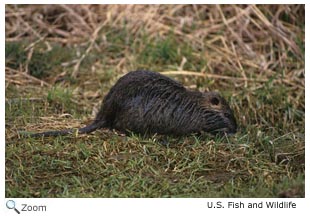Myocastoridae - nutrias
 There is one living species in this family. Nutrias are large aquatic rodents. They are native to Central and South America, but they have been introduced to parts of the United States, especially the southeastern United States. The nutria has also been introduced in Asia and Europe. There is one living species in this family. Nutrias are large aquatic rodents. They are native to Central and South America, but they have been introduced to parts of the United States, especially the southeastern United States. The nutria has also been introduced in Asia and Europe.
Nutrias are about three feet in length and weigh around 30-35 pounds. They have thick, reddish-brown fur; short legs; webbed rear feet; small ears; and small eyes. They have big heads with a squared muzzle; long, round, lightly haired pointed tails; and whiskers.
Nutrias are found found near lakes, ponds, swamps, rivers, and marshes. A nutria can stay submerged underwater for several minutes and sometimes it floats in the water with just its nose and eyes above the water! The nutria eats land plants and aquatic plants. The nutria is also known as the coypu.
World Status Key
 Least Concern Least Concern  Near Threatened Near Threatened  Vulnerable Vulnerable  Endangered Endangered  Critically Endangered Critically Endangered  Extinct in Wild Extinct in Wild  Extinct Extinct
Status and range is taken from ICUN Redlist. If no status is listed, there is not enough data to establish status.
US Status Key
 Threatened in US Threatened in US  Threatened in NH Threatened in NH  Endangered in US Endangered in US  Endangered in NH Endangered in NH  Introduced Introduced
Status taken from US Fish and Wildlife and NH Fish and Game
New Hampshire Species |
|
North/Central American Species |
None
|
|
Nutria - Myocastor coypus   |
Additional Information
Key:  Profile Profile  Photos Photos  Video Video  Audio Audio
Nutria - Myocastor coypus [im]     
The nutria is also known as the coypu.
Source: Arkive Intended Audience: General Reading Level: Middle School
Nutria - Aonyx capensis - Myocastor coypus [in][im]     
Populations of nutrias are found in North America, Europe and Asia because nutrias escaped are were released from fur farms.
Source: Animal Diversity Web Intended Audience: General Reading Level: Middle School
Nutria - Aonyx capensis - Myocastor coypus [in][im]     
Nutrias sometimes live in large colonies.
Source: National Geographic Intended Audience: General Reading Level: Middle School |

